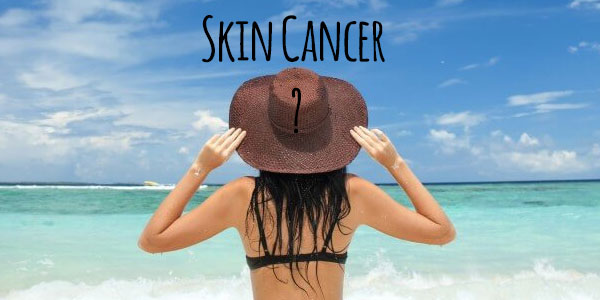
Mal-illumination is equivalent to malnutrition. Most people are very familiar with the term malnutrition, but have never heard of the term mal-illumination. I want to make the case in this post that this mal-illumination is probably just as important as malnutrition.
“Mankind adapted to the full range of the solar spectrum, and artificial distortions of that spectrum – mal-illumination, a condition analogous to malnutrition — may have biologic effects.”
Light plays a critical role in managing
- Circadian rhythm
- Mitochondrial function
- Immune function
- Inflammatory signaling
- Hormonal system
- Neurotransmitters
Most of us live 90+% of the time indoors and we’re not getting nearly as much sun as we have for basically all of human evolution of millions of years. It’s only since the last few decades that we’ve shifted mostly to an indoor light lifestyle.
The Five Bioactive Types of Light
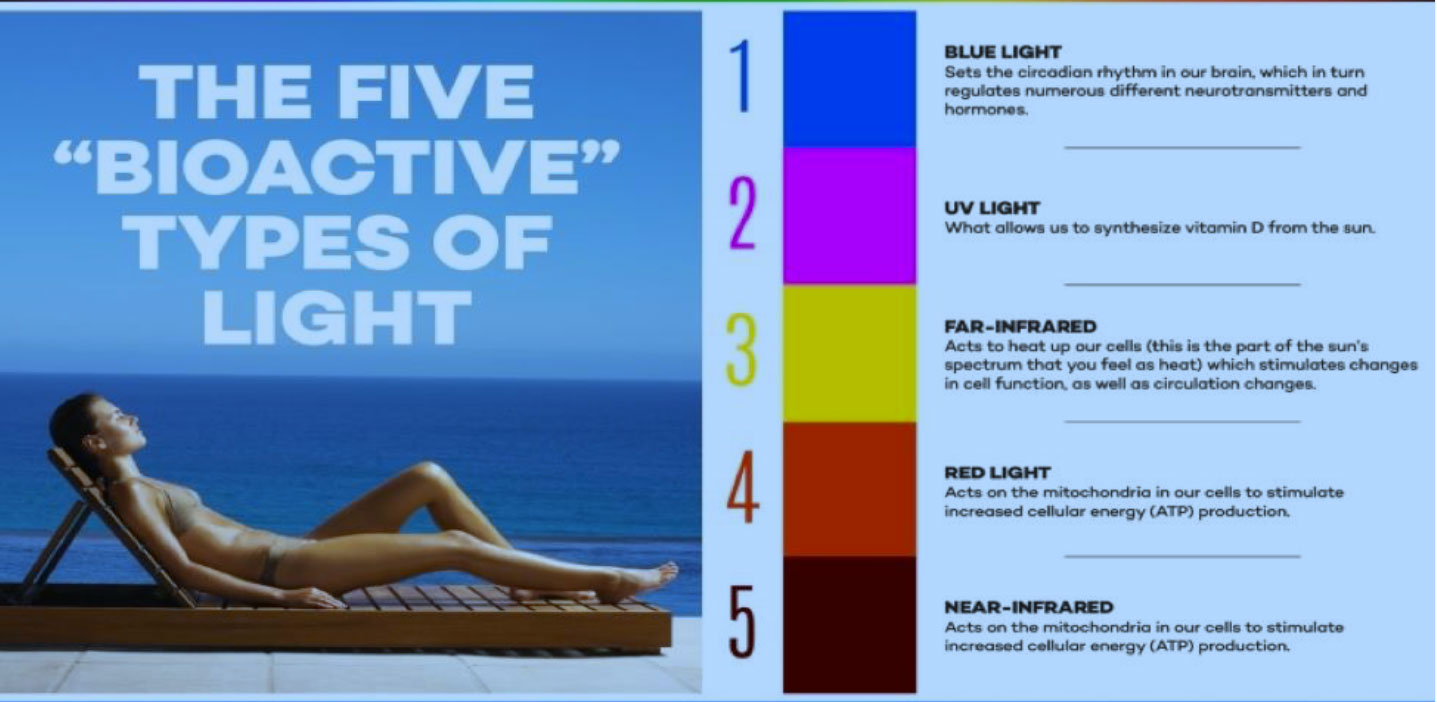
Blue Light
Blue light, and to some extent green light enters into our eyeballs, feeds back through nerves into the Suprachiasmatic nucleus (the circadian clock in your brain), and then regulates a variety of different neurotransmitters and hormones that control our sleep-wake cycles, energy levels, brain function, and many other aspects of our function.
Different light sources emit different wavelengths of light:
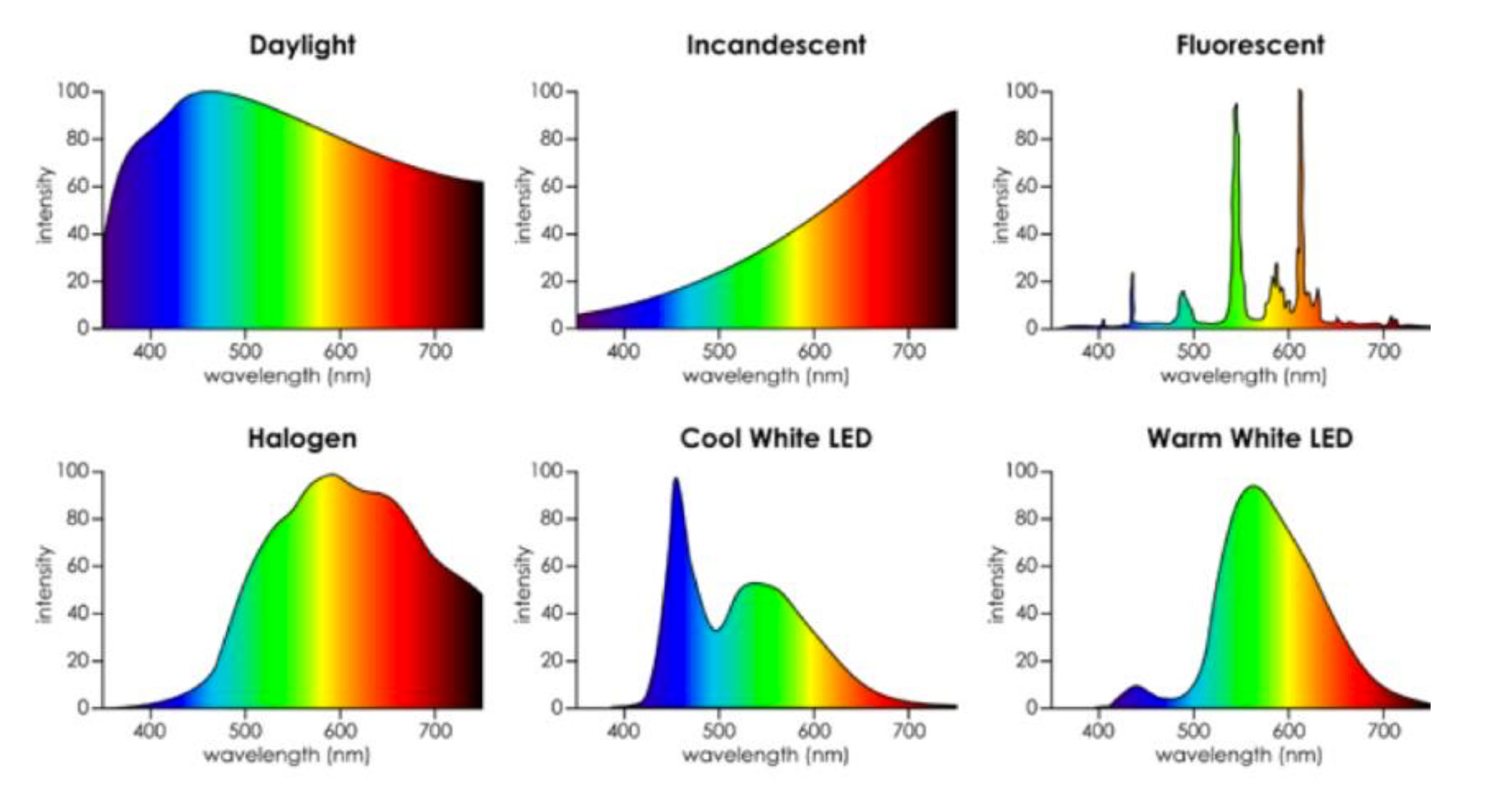
In general, for indoor lighting, especially evening lighting, I favor incandescent lighting because this mimics fire best.
UV Light
UV light is just on the smaller wavelength side of the visible light spectrum.
Vitamin D is synthesized in your skin as a result of exposure to UVB radiation. There’s a whole series of chemical events that happen in your skin as far as how cholesterol gets turned into vitamin D and then the active form of vitamin D and then absorbed into the bloodstream. And why is vitamin D important?
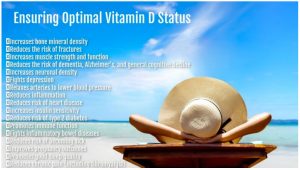
A day in the sun can provide up to about 25,000 IUs (international units) of vitamin D, which increases our blood levels for up to a week before declining. Typical vitamin D supplements on the other hand may provide somewhere like 500 to 5,000 IUs and stay in your system for less than 2 days.
Roughly 1 billion people worldwide are vitamin D deficient or insufficient, including 42% of Americans.
And you would find similar numbers among pretty much all the westernized countries where people are spending most of their days indoors.
How can you get vitamin D?
Most people think that vitamin D supplements are basically sunshine in a bottle. This is absolutely 100% wrong and insanely ignorant because taking a vitamin D supplement is not even close to a sufficient strategy to make up for a sunlight deficiency. So where do we get our vitamin D?
You can get a typical dose of Vitamin D of about 10,000 to 25,000 IU through the sun through a minimal Erythema dose of UV radiation. And what that means is simply staying out in the sun until you turn a little bit pink. Now that time is going to vary tremendously depending on your skin type and your current sun exposure adaptation.
You want your skin turning slightly pink, you don’t want to get sunburned.
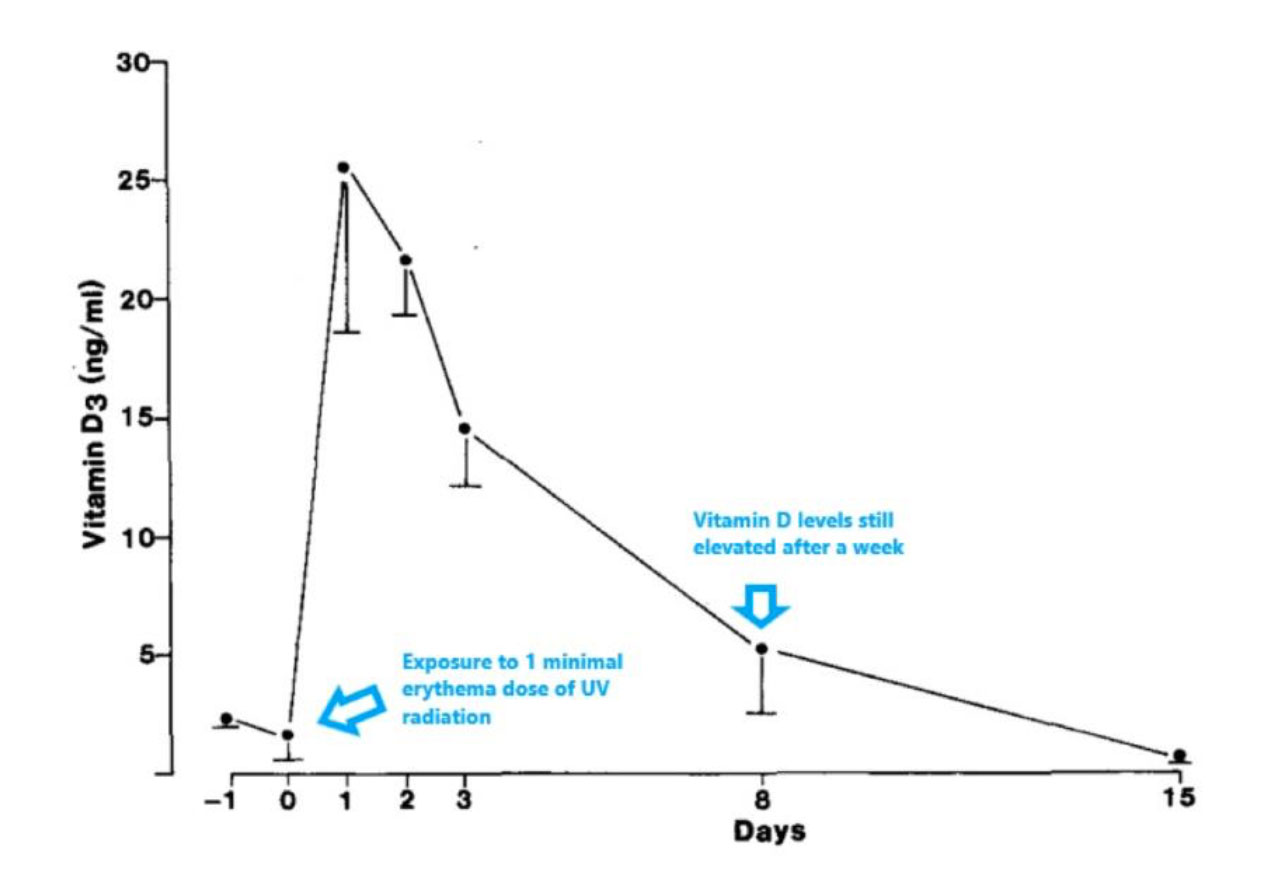
Studies show that it takes about eight hours for the vitamin D that we make in the skin to enter our bloodstream with levels rising until 24 hours after sun exposure and remaining elevated for up to one week. Comparatively, any vitamin D that we eat, including supplements leaves our body in about two days.
As it takes about eight hours for the vitamin D that is made via the skin to enter our bloodstream, there is some indication that taking a shower after sun exposure and soaping up your skin and scrubbing your skin could potentially wash off some of that vitamin D.
In this study a group of white and black people were exposed to the same amount of UVB radiation in a tanning bed. Whereas the white adults raise their blood levels of vitamin D more than 30-fold, no change was seen in the black adults who were instead required being exposed to five times more UVB radiation to experience a 15-fold increase in vitamin D levels. The point here is that darker skin takes more sunlight and more ultraviolet light exposure in order to synthesize a given amount of vitamin D.
We can break things down in terms of what is called the Fitzpatrick skin type scale:
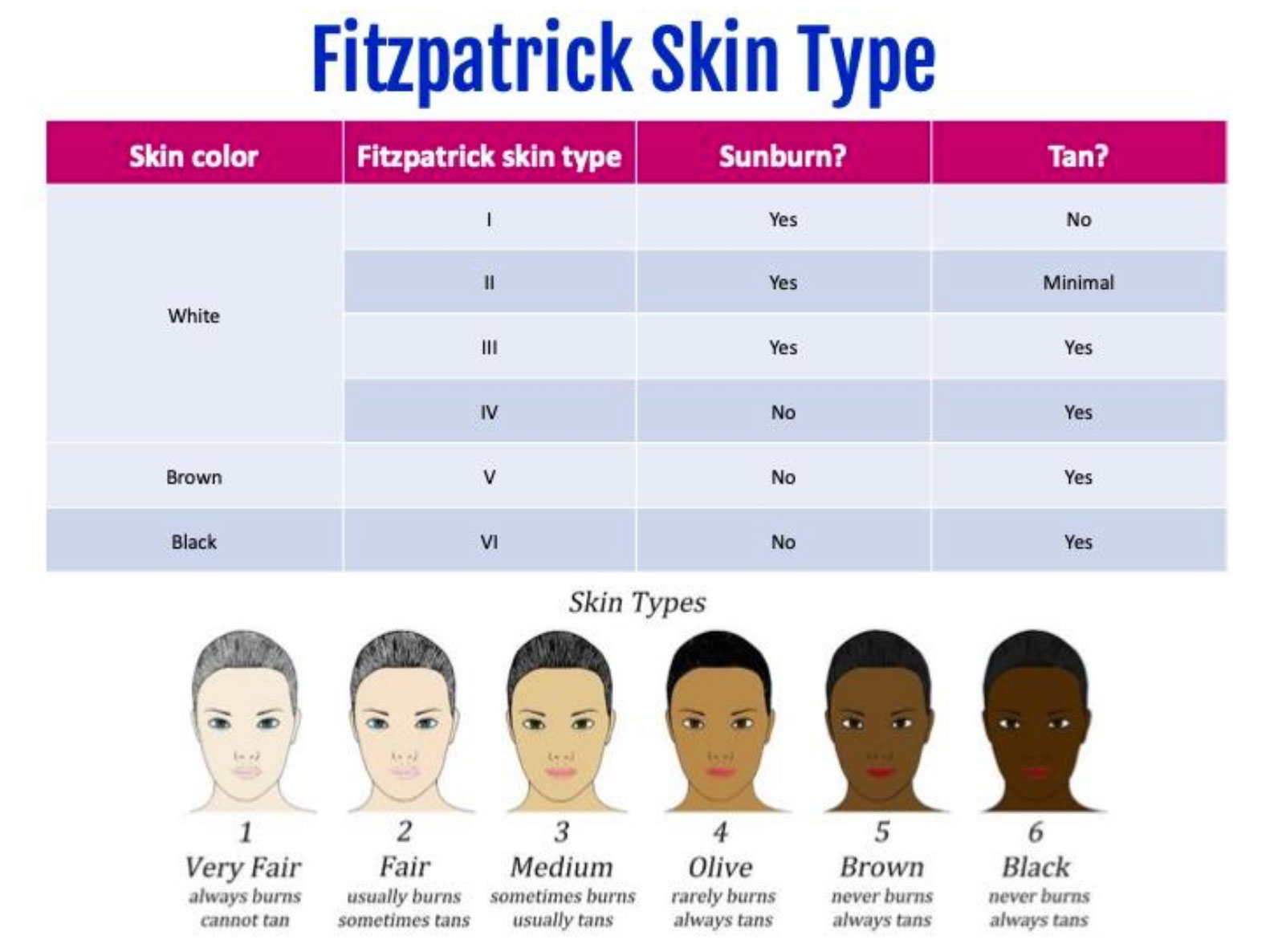
There are six different kinds of skin types. In general, as you have lighter skin, you will have lower tolerance to sun exposure and lower actual needs for sun exposure in order to synthesize adequate levels of vitamin D. And vice versa. The darker your skin, the more easily you will tan and the more overall ultraviolet light and sun exposure you’ll need to synthesize adequate levels of vitamin D.
The goal here is to protect the skin from damage by building up a lot of Melanin in the skin, and to have hours of sun exposure producing a proper dose of vitamin D.
In regions very far from the equator (like Ireland, Scotland and Scandinavia) the UVB exposure is so minimal that the skin adapted to get a sufficient dose of vitamin D with even very minimal amounts of sun exposure. So be aware!
Should I be concerned about Skin Cancer from UV Exposure?
Non-burning sun exposure (below the threshold of what causes a sunburn) does not increase your risk of skin cancer.
So, when somebody who spends most of their time indoors, (maybe as an office worker or in a climate that doesn’t get much sun exposure) goes on a vacation and get lots of sun exposure, spending hours a day in the sun and getting burned. Doing that consistently over the years is going to lead to an increase in the risk of melanoma.
So, should you be concerned about skin cancer from sun exposure? Well, just keep in mind that humans evolved under relatively constant sunlight exposure and the body has numerous defenses against such damage, including DNA repair mechanisms, cell cycle and growth inhibitions, reduced proliferation, enhanced sensitivity to apoptosis, and enhancement of cellular differentiation and anti-inflammatory effects, many of which are related to vitamin D produced by exposure to UVB. The body isn’t stupid.
Since about 1975 there has been a massive increase in rates of skin cancer. Now keep in mind that this huge increase in this epidemic of skin cancer corresponds to a 30-fold increase in the use of sunscreen and spending more and more times indoors.
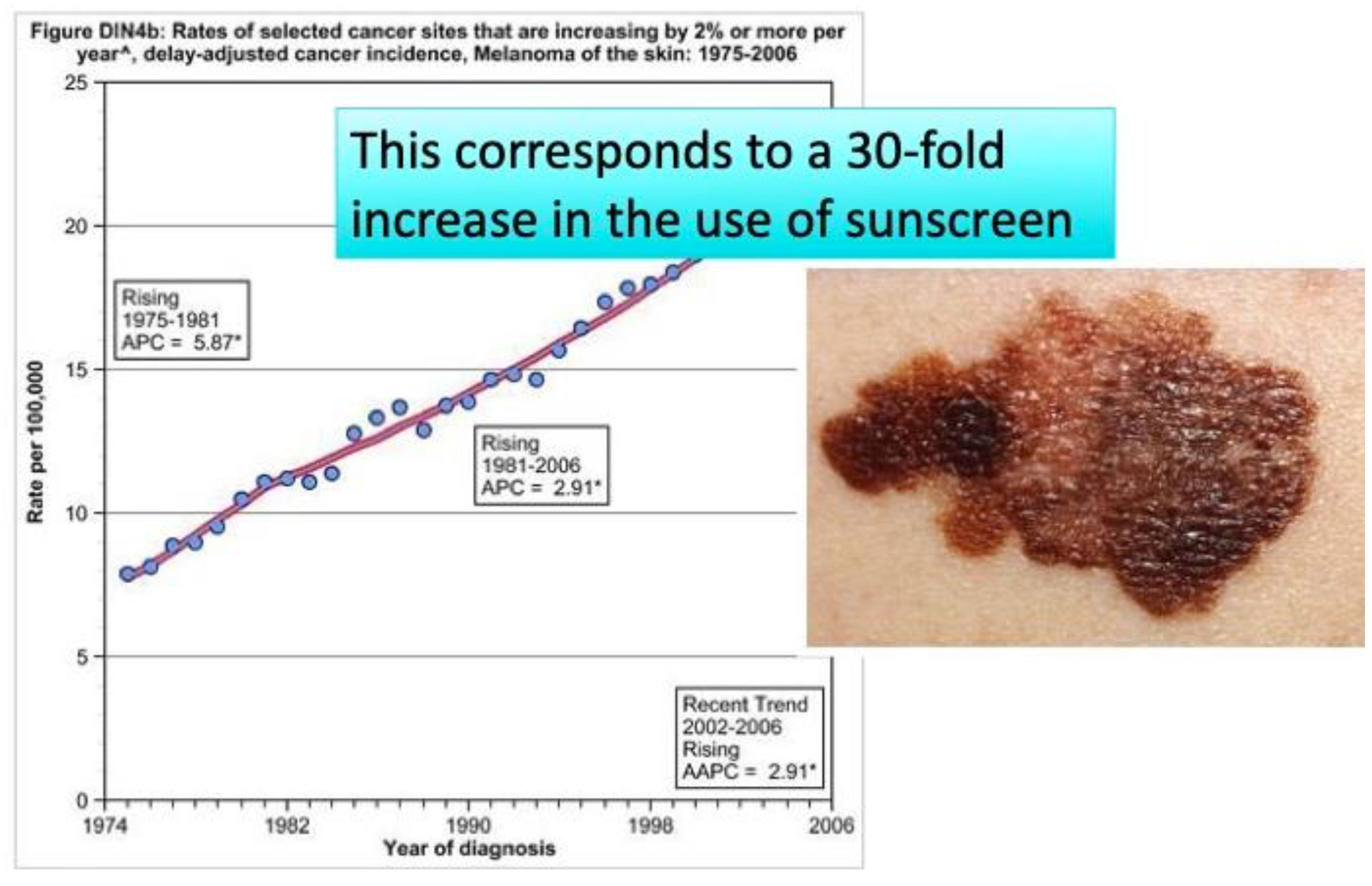
There’s no way to account for this massive upward trend in the incidence of skin cancer by saying, hey, people are just spending way more time outdoors in the sun, because we’ve all shifted from indoor computer jobs to outdoor jobs where we’re working in the sun.
No, in fact, the opposite has happened over the last several decades. More and more people have shifted from outdoor jobs, where they’re getting sun exposure for hours a day, to indoor office work, where they’re being removed from sun exposure. Keep in mind that it is extremely common for indoor office workers who get little to no sun exposure to have melanoma and skin cancer. So, there isn’t this sort of direct correlation between the more sun exposure you get, the more skin cancer you got.
Also keep in mind the bigger picture of the overall pie of the relationship of sun exposure to cancer. Sun exposure dramatically reduces the risk of many, many types of cancer and many other diseases.
This study quantifies exactly how much sun reduces the risk of other diseases by looking at our risk of all-cause mortality:
40,000 women in Sweden were monitored for 15 years looking at their sunbathing vacations and incidents of sunburn.The study found that increased sunburn frequency was associated, believe it or not, with reduced all- cause mortality. Also sunbathing vacations more than once a year reduced risk of cardiovascular disease and all-cause mortality.
So, what this is really saying is that people who have more frequent sun exposure reduce their all-cause mortality. But the point is, even when this sometimes resulted in sunburn, there was still a massively reduced risk of dying from any cause.
Further studies blowing into the same horn:
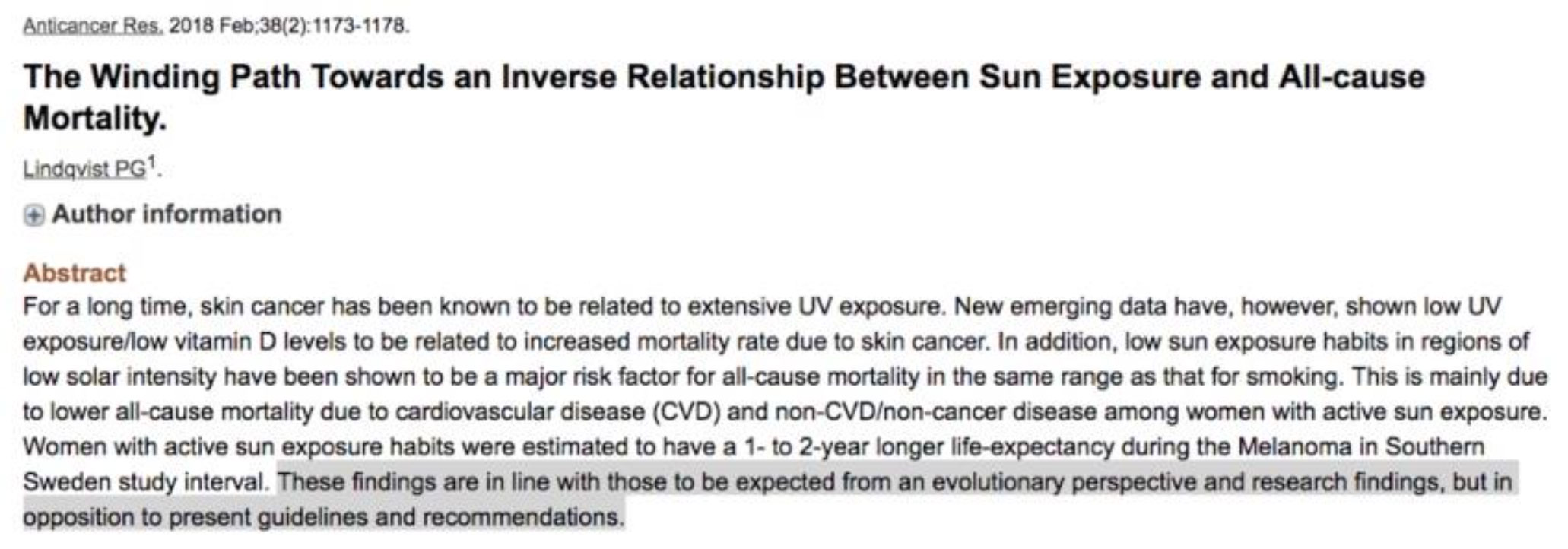
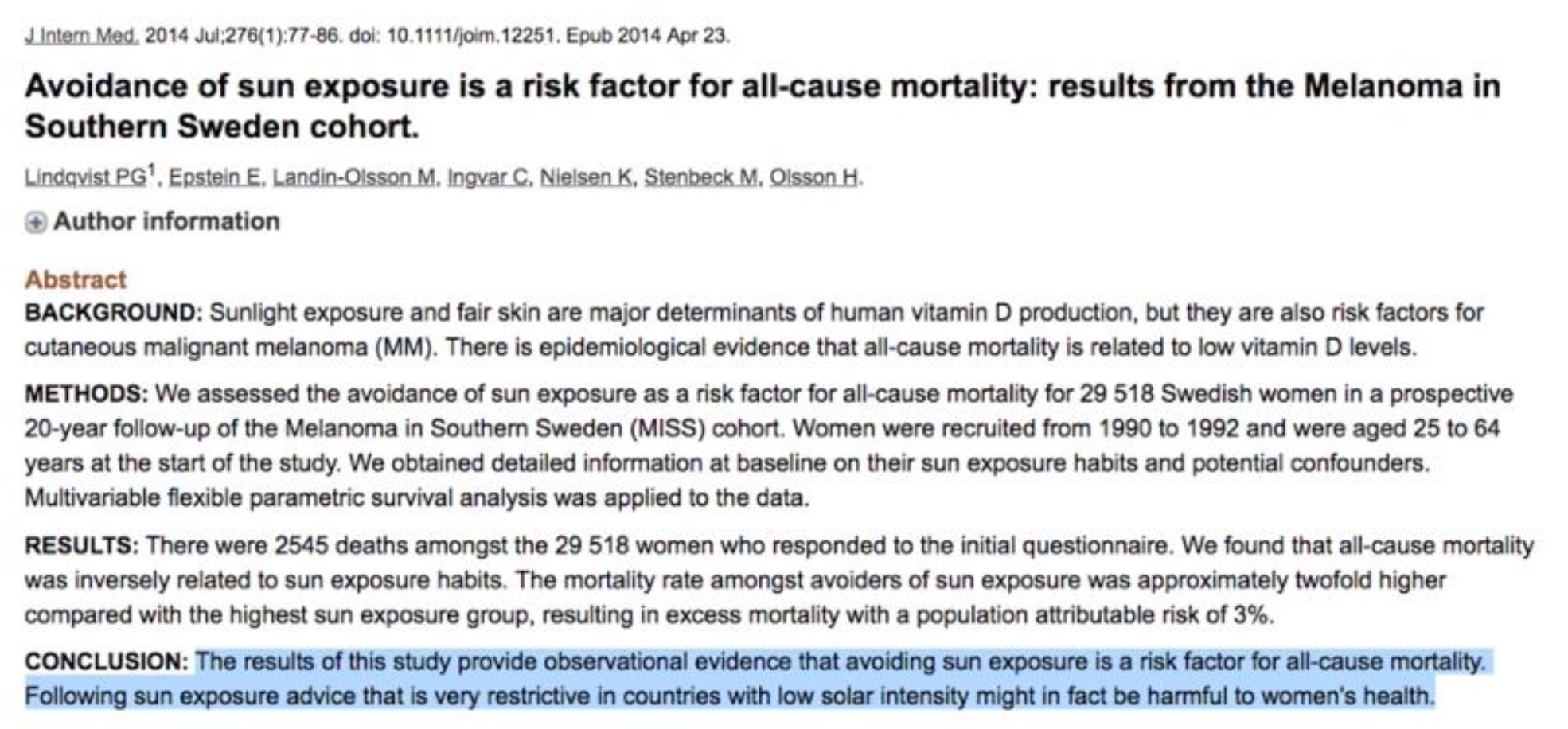

This last study concluded that nonsmokers who avoided sun exposure had a life expectancy similar to smokers in the highest sun exposure group, indicating that avoidance of sun exposure is a risk factor for death of a similar magnitude as smoking, essentially saying:
“If you are avoiding sun, you’re doing something as harmful to your health as smoking a pack of cigarettes a day.”
Dos and Don’ts of Sun Exposure
Avoid tanning through a window as it increases your skin cancer risk
Because UVA has a longer wavelength than UVB radiation, it penetrates materials and the earth’s atmosphere further. Window glass will therefore effectively filter out the majority of UVB radiation, but only minimally remove UVAs. What’s the significance of that, you ask?
It is important to remember that vitamin D3 is formed from exposure to UVB rays, whereas UVA radiation actually destroys vitamin D. This helps keep your body in balance; it’s one of the protective mechanisms your body has to avoid overdosing on vitamin D when you’re outside.
However, when you are exposed to sunlight through windows — in your office, your home or your car — you get UVA, but virtually none of the beneficial UVB. This can lead to significant health problems, because in addition to destroying vitamin D3, UVA’s also increase oxidative stress.
UVA is one of the primary culprits behind skin cancer, and it increases photo-aging of your skin. It is also what causes you to tan. You can get vitamin D without significantly darkening your skin, because the UVB wavelength does not stimulate the Melanin pigment to produce a tan. Normally, of course, when you get tanned from outdoor sun exposure you are getting both UVA and UVB at the same time, so it is not a problem. But when you are indoors and expose yourself to sunlight filtered through window glass, you are increasing your risk of a variety of conditions, primarily skin cancer, because the UVA’s are effectively destroying your vitamin D3 levels while you’re getting none of the benefits from UVB.
This is one of the reasons why many that drive long hours in their cars develop skin cancer on the arm next to the car window.
Midday UV light is critical
Midday sun has the highest proportion of UVB, which is critical for synthesis of vitamin D and Melanin.
Non-burning sun exposure sessions around noon for ~20 minutes (or more if you have more sun tolerance) are ideal.
Sunlight, Hormones and Healing
Full body sun exposure (to ALL parts of your naked body, including your nether regions) is ideal to get hormonal benefits. (Cover moles or see a dermatologist to have any reactive moles removed).
Sex hormones boosted by full body sun exposure have a massive impact on brain function, health, energy levels, and body composition.
Should you wear Sunscreen?
If you work outdoors all day, or if you need to protect sensitive areas of your face (like around your eyes), safe sunscreen is certainly recommended. But if you apply sunscreen every time you are out in the sun, you will block your body’s ability to produce vitamin D and cholesterol sulfate.
Before using sunscreen, I recommend drawing all the registers of textile and behavioral protection.
There is mineral-based sunscreen which only builds up a layer on the skin and then there are chemical sunscreens that are absorbed by the skin, entering the bloodstream, changing the concentration, and acting as endocrine disruptors-you can even detect them in breast milk.
It depends. If you are stranded on a ship with no clothes you should use it to prevent severe sunburn. But as a strategy to avoid solar overdosage, it is not good.
Minimize time in the sun without sunscreen to prevent sunburn—go slowly and progressively to increase your skin’s tolerance (Melanin).
Use textiles (clothes, hats, scarfs, etc.) to cover up any sensitive areas (face). If you must use sunscreen for any reason, use a mineral-based sunscreen, not a chemical one. You can also make your own very simply and cheaply with zinc oxide powder and coconut oil.
What to do if you get sunburned
If you ever develop a sunburn, it is important to realize that aloe vera is one of the best remedies to help repair your skin as it is loaded with powerful glyconutrients that accelerate healing. Ideally, it is best to use the gel from a fresh plant, but there are commercial products available that have active aloe in them.
Ideally, you would never need it, because you are using safe tanning guidelines, but accidents do happen, and it is important to have contingency plans for them.
No, 10 Minutes per Day of Sun UVB is NOT enough
Many people and doctors believe that 10 minutes a day in the sun a few days of the week provides enough vitamin D. They are wrong most of the time.
5-10 minutes is enough only if you are near the equator
and young
and not obese
and have light skin
and it is summer
and it is the middle of the day
and you have lots of skin exposed to the sun and you are lying down
and you are not wearing sunscreen.
Time in the Sun to get 4,000 IU of Vitamin D
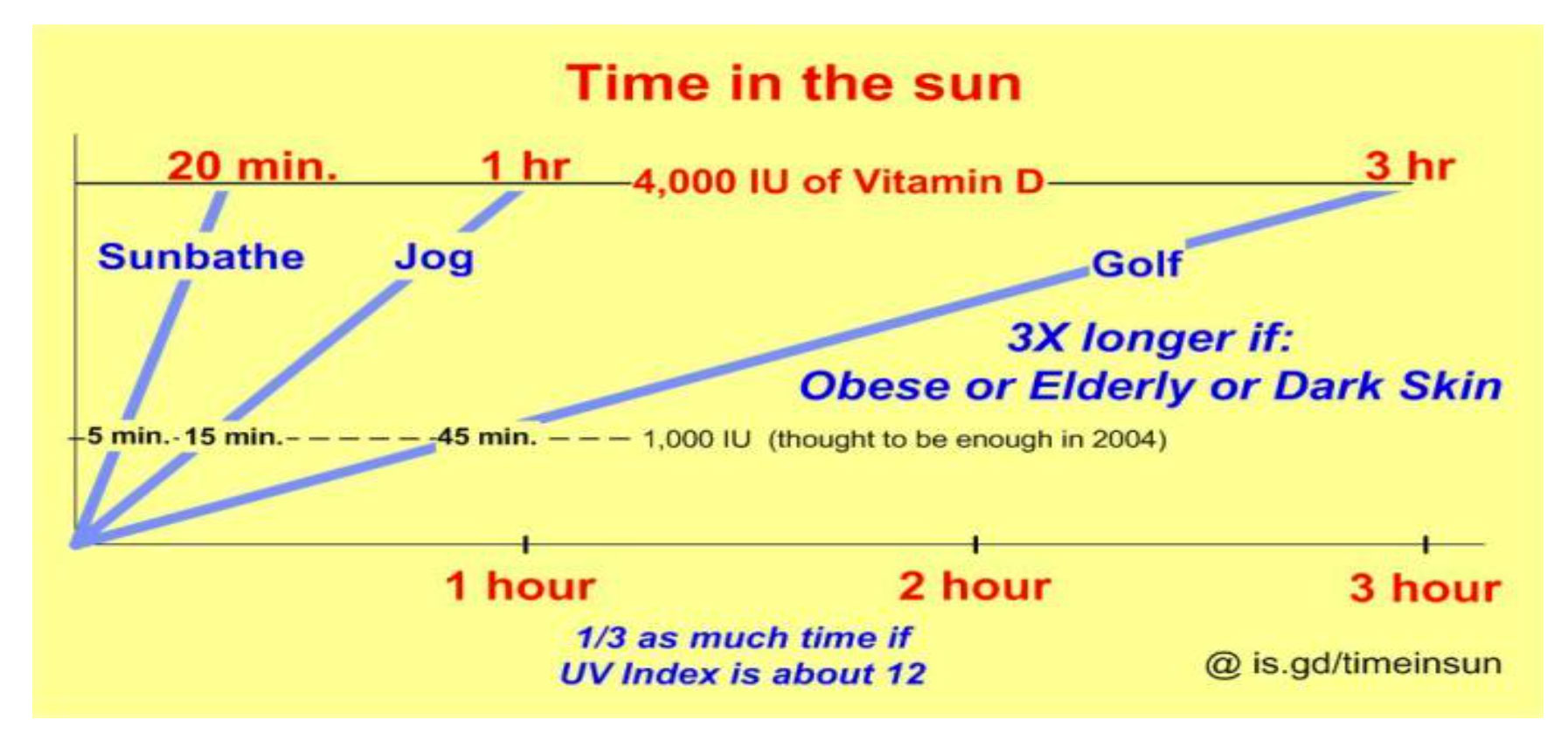
Based on your skin color and body composition as well as the time of day and climate you live in, your sun exposure needs in the following changes:
– Obese (2X more minutes)
– Black Skin (5X more minutes)
– Early morning or late afternoon sun (2X more minutes)
-Sun during Spring or Fall ( shoulder season >2X more minutes)
– Urban haze – perhaps 2X or 4x more minutes
How many minutes of Mid-Day Summer Sun?
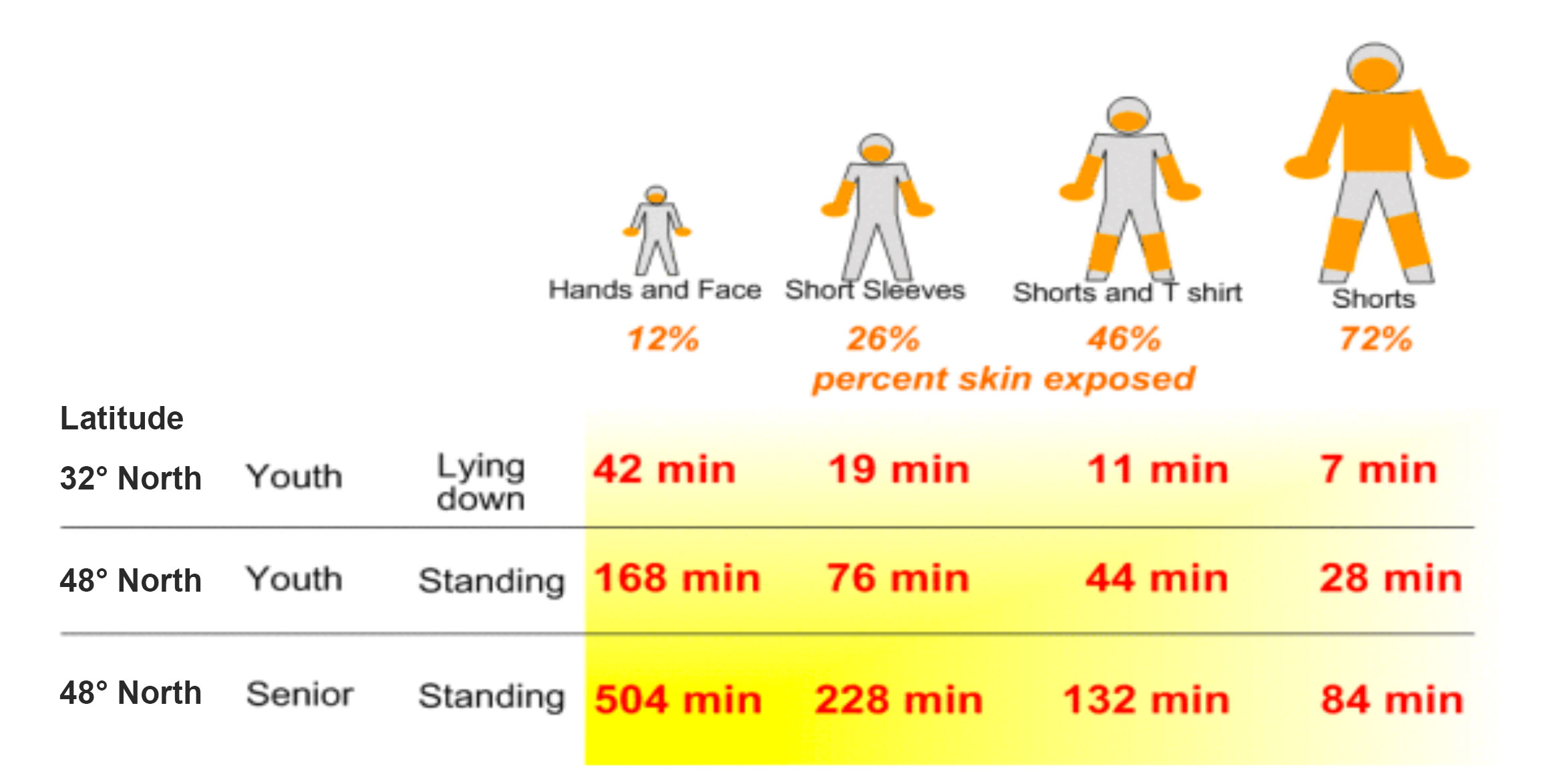
Effects of Red, Infrared and Far Infrared
These effects will be discussed in another post coming soon 😉
